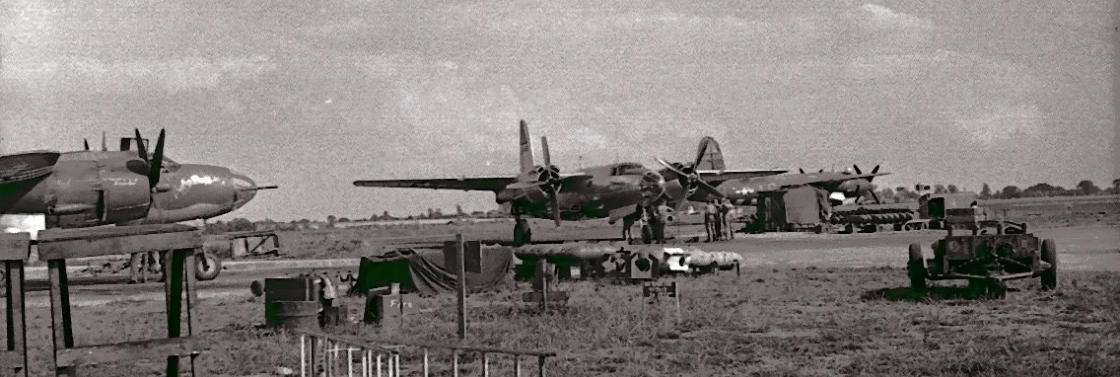
USAAF Matching Green History
Ordnance Survey data © Crown copyright and database right 2011
A
few
miles
to
the
East
of
Harlow
are
the
remains
of
Matching
Green
Airfield.
The
land
had
been
earmarked
for
use
as
an
airfield
from
as
early
as
1937
during
the
rapid
build
up
of
resources
for
the
RAF.
Construction
eventually
began
in
1943
as
an
airfield
for
the
United
States
Army
Air
Force.
As
in
common
with
most
of
the
US
airfields
in
the
area,
it
was
a
base
for
B-26
Martin
Marauder
twin
engined medium bomber Groups who were under control of the US 9th air force.
Known
as
Station
166,
it
was
built
by
the
US
834th
and
840th
Engineer
(Aviation)
Battalions,
to
"Class
A"
standards.
The
runways
were
150'
wide
with
a
50'
wide
perimeter
track
running
around
the
main
flying
field.
Five
dispersed
sites
were
used
for
administration,
living,
and
technical
support.
Two
T2
type
Hangars
were
also
erected.
These
measured
240'
long,
39'
high, with a 120' span across the doors.
The
airfield
carried
the
pundit
code
of
MC.
This
would
have
been
marked
in
large
white
letters
on
the
signals
square
next
to
the Control Tower. The first Americans to be posted in were the members of the 13th Replacement Control Depot.
The Hand over ceremony from the RAF to the USAAF in 1944. The blister hangar in the background still exists with the control tower
just visible to the far left.
The
9th
USAAF
391st
Bomb
Group
led
by
Colonel
Gerald
E
Williams
and
consisting
of
the
572nd,
573rd,
574th,
and
575th
Bomb
squadrons
flying
B-
26
Marauders,
moved
in
on
the
25th
of
January
1944.
This
was
during
the
final
phase
of
construction.
The
391st
commenced
operations,
and
stayed
until
the
1st
October,
1944,
just
nine
months.
but
during
this
time
they
flew
6,000
sorties
with
the
loss
of
197
men
killed,
wounded,
or
missing
in
action.
On
D-Day,
6th
June
1944
the
group
flew
two
missions
against
enemy
gun
positions
on
the
invasion
coast,
with
two
German
fighter
aircraft
being shot down by the groups gunners .
B-26 Marauders of the 391st taxi to a position for take off. The same location today shows the remains of the perimeter track,
although the runway has long since gone.
Lt William Kloepfer (pilot) Killed in Action
Lt John Hultin (2nd pilot) Killed in Action
2nd Lt Edward Wolf Killed in Action
S/sgt Delmar Haynes Prisoner Of War
S/sgt James Stevens Killed in Action
When the aircraft was lost due to a fire in
the bomb bay while on the fateful mission to
Ahrweiler Germany during the Ardennes
offensive on the 23/12/1944.
The Group lost 17 aircraft on that one mission.
B-26 'Miss Behaving' 42-95844. 75th Squadron, 391st Bomb Group (M)
391st personnel relax in the bar back on the airfield at Matching in 1944, the decay in the building was profound in 2006.
USAAF officers await the return of aircraft on the balcony of the tower circa 1944.
The Free Gunnery Trainer. Formerly an Over blister aircraft hangar that was once used as a dry store for bagged cement
when the airfield was under construction. It was then sited on the tech site and used as a gunnery training building.
Interior showing the lattice work construction of these Blister hangars
Gas Clothing and Respirator Store
A
few
weeks
after
D-Day,
airfields
were
becoming
available
to
the
RAF
and
USAAF,
the
2nd
October
1944,
the
group
moved
to
Roye-Amy,
France
(A-73).
This
was
a
former
Luftwaffe
airfield,
and
operations
commenced
from
there.
For
a
brief
time
plans
were
laid
to
make
Matching
airfield
one
of
the
proposed
VHB,
or
Very
Heavy
Bomber,
bases,
to
handle
the
B-29
Boeing
Superfortress
Bombers,
should
they
be
needed
in
the
European
theatre
of operations. But many objections were apparently lodged, and so the plans were dropped.
For
a
few
weeks
C
-
47
Skytrain
(Dakota)
transport
aircraft
from
the
US
9th
Troop
Carrier
Command,
used
Matching
Green
for
training
with
British
Paratroopers.
Soon
after,
the
RAF
arrived
with
Short
Stirling
Mk
4
Bombers
of
38
Group,
which
were
used
in
the
role
of
Tugs
for
the
large
Horsa
Gliders
in
the
upcoming
"Operation
Varsity".
This
was
to
be
the
largest,
and
most
succesful,
of
the
airborne
operations,
involving
12
parachute
battalions,
five
British,
one
Canadian,
and
six
from
the
USA,
closely
followed
by
1300
Horsa
gliders
packed
with
troops.
Fourteen
aircraft
and
their
attendant Gliders carrying British troops took off from Matching in this operation.
Shortly
after,
the
squadrons
in
38
Group
converted
to
Handley
Page
Halifax
Mk3
aircraft.
Six
months
after
conversion
they
left,
and
flying
finally
ceased
from
Matching
.
It
has
now
returned
to
agricultural
land
use
but
much
remains
to
be
seen
today.
The
Control
Tower
still
stands
and
is
home
to
a modern radar equipment testing facility owned by Ratheon.
What is left?
On
the
site
of
the
officers
camp,
the
tall
water
tower
stands
amongst
various
Nissen
and
Romney
huts.
Not
far
away
and
near
to
the
former
Ambulance
station
and
Mortuary
on
the
sick
quarters
site,
is
the
memorial
to
the
391st
Bomb
Group
(Medium).
A
plaque
can
also
be
seen
in
the
church
of
St
Mary
The
Virgin
commemorating
the
391st
Bomb
Group.
All
the
runways
have
been
lifted,
leaving
just
a
ten
foot
wide
section
used
as
a
convenient road through the crops.
There is a very small section of full width runway remaining.
This
is
on
the
Western
side
of
the
airfield,
and
linked
by
a
remaining
section
of
perimeter
track.
The
site
of
the
bomb
dump
in
nearby
Brickles
Wood
retains
the
earth
blast
walls
between
the
bomb
storage
bays
and
brick
walls,
but
now
covered
by
undergrowth
and
small
trees,
evidence
of
former
buildings
in
the
bomb
dump
can
also
be
found
with
only
the
concrete
floors
remaining.
The
service
road
can
still
be
seen
passing
through
the
site.
A
man made lake, possibly dug as an emergency water supply, can also be found.
One of the main aviation fuel store remains intact. The pump house , vent pipes, and bowser filling heads still in situ is very near to Stock Hall.
At
the
Northern
end
of
the
airfield,
the
large
shaped
mound
of
earth
that
was
used
as
a
test
range
for
the
aircraft
machine
guns
is
evident
.
Part
of
this
mound is missing at one end, soil was used to level the ground after the nearby aircraft hardstands were taken up a few years ago.
One
of
the
"T2"
type
aircraft
Hangers
was
re-erected
at
North
Weald
airfield.
It
has
been
re
-
clad
in
modern
materials,
and
is
still
used
for
aviation
puposes. It was once used as a studio for the television series "The Crystal Maze".
Many
of
the
remaining
Nissen
and
Romney
huts
have
been
re
clad
in
modern
materials
and
are
being
used
for
light
commercial
enterprises.
The
former
Hospital
unit
is
a
few
yards
from
the
memorial,
they
too
have
been
reclad
and
put
to
use
again.
Around
90%
of
the
perimeter
track
circuit
remains,
albeit
cut
down
to
around
a
10
foot
wide
strip
for
most
of
its
length.
Only
two
short
sections
are
missing.
On
the
eastern
side
of
the
airfield
part of the peritrack is still in its original width.
Also
in
the
Technical
site
area
is
the
Free
Gunnery
trainer
in
the
blister
hangar,and
part
of
a
loop
hardstand,
Crew
locker
and
Drying
Room,
Gas
Clothing and Respirator Store.
A
little
further
on
the
Admin
area
retains
the
Norden
bombsight
store
and
the
Ops
block,
both
of
which
are
hidden
in
dense
scrub
and
bushes.
These
are also on private land and are subject to planning permission that may see the demolition of these soon.
From
the
air
you
can
still
make
out
the
general
outline
of
many
of
the
airfields
features.
It
is
still
possible
to
see
where
the
hardstands
and
runways
were. The shape of these still show up through the crops, and will probably do so for quite some time.
With special thanks to: Michael Scantlebury of Manwood Farm, Henry Rowe of Rookwood Hall Farm, Geoffrey Broad of Snows Farm,
David Parsons of Stock Hall, for allowing me access to the land.
All images and text © wartime airfields. Wartime photos © & sourced from Footnote.com USA





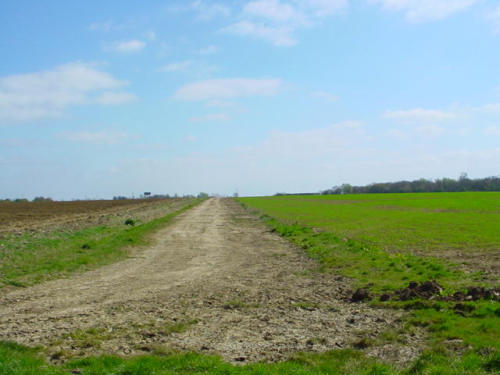










Wartime Airfields
rjkdesign
Wartime Airfields
rjkdesign


Wartime Airfields
Wartime Airfields

USAAF Matching Green History

Ordnance Survey data © Crown copyright and database right 2011
A
few
miles
to
the
East
of
Harlow
are
the
remains
of
Matching
Green
Airfield.
The
land
had
been
earmarked
for
use
as
an
airfield
from
as
early
as
1937
during
the
rapid
build
up
of
resources
for
the
RAF.
Construction
eventually
began
in
1943
as
an
airfield
for
the
United
States
Army
Air
Force.
As
in
common
with
most
of
the
US
airfields
in
the
area,
it
was
a
base
for
B-26
Martin
Marauder
twin
engined
medium
bomber Groups who were under control of the US 9th air force.
Known
as
Station
166,
it
was
built
by
the
US
834th
and
840th
Engineer
(Aviation)
Battalions,
to
"Class
A"
standards.
The
runways
were
150'
wide
with
a
50'
wide
perimeter
track
running
around
the
main
flying
field.
Five
dispersed
sites
were
used
for
administration,
living,
and
technical
support.
Two
T2
type
Hangars
were
also
erected.
These
measured
240'
long,
39'
high,
with
a
120' span across the doors.
The
airfield
carried
the
pundit
code
of
MC.
This
would
have
been
marked
in
large
white
letters
on
the
signals
square
next
to
the
Control
Tower.
The
first
Americans
to
be
posted
in
were the members of the 13th Replacement Control Depot.
The Hand over ceremony from the RAF to the USAAF in 1944. The
blister hangar in the background still exists with the control tower
just visible to the far left.
The
9th
USAAF
391st
Bomb
Group
led
by
Colonel
Gerald
E
Williams
and
consisting
of
the
572nd,
573rd,
574th,
and
575th
Bomb
squadrons
flying
B-26
Marauders,
moved
in
on
the
25th
of
January
1944.
This
was
during
the
final
phase
of
construction.
The
391st
commenced
operations,
and
stayed
until
the
1st
October,
1944,
just
nine
months.
but
during
this
time
they
flew
6,000
sorties
with
the
loss
of
197
men
killed,
wounded,
or
missing
in
action.
On
D-Day,
6th
June
1944
the
group
flew
two
missions
against
enemy
gun
positions
on
the
invasion
coast,
with
two German fighter aircraft being shot down by the groups gunners.
B-26 Marauders of the 391st taxi The same location today shows
to a position for take off. the remains of the perimeter ttrack,
although the runway has long since
gone.
B-26 'Miss Behaving' 42-958 75th Squadron, 391st Bomb Group (M)
Lt William Kloepfer (pilot) Killed in Action
Lt John Hultin (2nd pilot) Killed in Action
2nd Lt Edward Wolf Killed in Action
S/sgt Delmar Haynes Prisoner Of War
S/sgt James Stevens Killed in Action
When
the
aircraft
was
lost
due
to
a
fire
inthe
bomb
bay
while
on
the
fateful
mission
toAhrweiler
Germany
during
the
Ardennes
offensive
on
the 23/12/1944. The Group lost 17 aircraft on that one mission
391st personnel relax in the bar back on the airfield at Matching in
1944, the decay in the building was profound in 2006.
USAAF officers await the return of aircraft on the balcony of the tower
circa 1944.
The Free Gunnery Trainer. Formerly an Over blister aircraft hangar that
was once used as a dry store for bagged cement
when the airfield was under construction. It was then sited on the tech
site and used as a gunnery training building.
Interior showing the lattice work construction of these Blister hangars
Gas Clothing and Respirator Store
A
few
weeks
after
D-Day,
airfields
were
becoming
available
to
the
RAF
and
USAAF,
the
2nd
October
1944,
the
group
moved
to
Roye-Amy,
France
(A-73).
This
was
a
former
Luftwaffe
airfield,
and
operations
commenced
from
there.
For
a
brief
time
plans
were
laid
to
make
Matching
airfield
one
of
the
proposed
VHB,
or
Very
Heavy
Bomber,
bases,
to
handle
the
B-29
Boeing
Superfortress
Bombers,
should
they
be
needed
in
the
European
theatre
of
operations.
But
many
objections
were apparently lodged, and so the plans were dropped.
For
a
few
weeks
C
-
47
Skytrain
(Dakota)
transport
aircraft
from
the
US
9th
Troop
Carrier
Command,
used
Matching
Green
for
training
with
British
Paratroopers.
Soon
after,
the
RAF
arrived
with
Short
Stirling
Mk
4
Bombers
of
38
Group,
which
were
used
in
the
role
of
Tugs
for
the
large
Horsa
Gliders
in
the
upcoming
"Operation
Varsity".
This
was
to
be
the
largest,
and
most
succesful,
of
the
airborne
operations,
involving
12
parachute
battalions,
five
British,
one
Canadian,
and
six
from
the
USA,
closely
followed
by
1300
Horsa
gliders
packed
with
troops.
Fourteen
aircraft
and
their
attendant
Gliders
carrying
British
troops
took
off
from
Matching in this operation.
Shortly
after,
the
squadrons
in
38
Group
converted
to
Handley
Page
Halifax
Mk3
aircraft.
Six
months
after
conversion
they
left,
and
flying
finally
ceased
from
Matching
.
It
has
now
returned
to
agricultural
land
use
but
much
remains
to
be
seen
today.
The
Control
Tower
still
stands
and
is
home
to
a
modern
radar
equipment
testing
facility
owned
by
Ratheon.
What is left?
On
the
site
of
the
officers
camp,
the
tall
water
tower
stands
amongst
various
Nissen
and
Romney
huts.
Not
far
away
and
near
to
the
former
Ambulance
station
and
Mortuary
on
the
sick
quarters
site,
is
the
memorial
to
the
391st
Bomb
Group
(Medium).
A
plaque
can
also
be
seen
in
the
church
of
St
Mary
The
Virgin
commemorating
the
391st
Bomb
Group.
All
the
runways
have
been
lifted,
leaving
just
a
ten
foot
wide section used as a convenient road through the crops.
There is a very small section of full width runway remaining.
This
is
on
the
Western
side
of
the
airfield,
and
linked
by
a
remaining
section
of
perimeter
track.
The
site
of
the
bomb
dump
in
nearby
Brickles
Wood
retains
the
earth
blast
walls
between
the
bomb
storage
bays
and
brick
walls,
but
now
covered
by
undergrowth
and
small
trees,
evidence
of
former
buildings
in
the
bomb
dump
can
also
be
found
with
only
the
concrete
floors
remaining.
The
service
road
can
still
be
seen
passing
through
the
site.
A
man
made
lake,
possibly
dug
as
an
emergency
water supply, can also be found.
One
of
the
main
aviation
fuel
store
remains
intact.
The
pump
house
,
vent
pipes,
and
bowser
filling
heads
still
in
situ
is
very
near
to
Stock
Hall.
At
the
Northern
end
of
the
airfield,
the
large
shaped
mound
of
earth
that
was
used
as
a
test
range
for
the
aircraft
machine
guns
is
evident
.
Part
of
this
mound
is
missing
at
one
end,
soil
was
used
to
level
the
ground
after the nearby aircraft hardstands were taken up a few years ago.
One
of
the
"T2"
type
aircraft
Hangers
was
re-erected
at
North
Weald
airfield.
It
has
been
re
-
clad
in
modern
materials,
and
is
still
used
for
aviation
puposes.
It
was
once
used
as
a
studio
for
the
television
series
"The Crystal Maze".
Many
of
the
remaining
Nissen
and
Romney
huts
have
been
re
clad
in
modern
materials
and
are
being
used
for
light
commercial
enterprises.
The
former
Hospital
unit
is
a
few
yards
from
the
memorial,
they
too
have
been
reclad
and
put
to
use
again.
Around
90%
of
the
perimeter
track
circuit
remains,
albeit
cut
down
to
around
a
10
foot
wide
strip
for
most
of
its
length.
Only
two
short
sections
are
missing.
On
the
eastern
side of the airfield part of the peritrack is still in its original width.
Also
in
the
Technical
site
area
is
the
Free
Gunnery
trainer
in
the
blister
hangar,and
part
of
a
loop
hardstand,
Crew
locker
and
Drying
Room,
Gas Clothing and Respirator Store.
A
little
further
on
the
Admin
area
retains
the
Norden
bombsight
store
and
the
Ops
block,
both
of
which
are
hidden
in
dense
scrub
and
bushes.
These
are
also
on
private
land
and
are
subject
to
planning
permission that may see the demolition of these soon.
From
the
air
you
can
still
make
out
the
general
outline
of
many
of
the
airfields
features.
It
is
still
possible
to
see
where
the
hardstands
and
runways
were.
The
shape
of
these
still
show
up
through
the
crops,
and
will probably do so for quite some time.
With special thanks to: Michael Scantlebury of Manwood Farm, Henry
Rowe of Rookwood Hall Farm, Geoffrey Broad of Snows Farm,
David Parsons of Stock Hall, for allowing me access to the land.
All images and text © wartime airfields. Wartime photos © & sourced
from Footnote.com USA


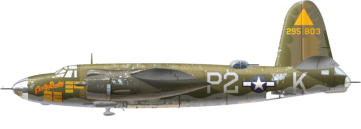

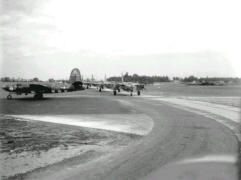







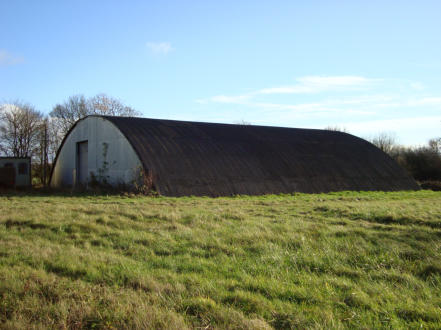


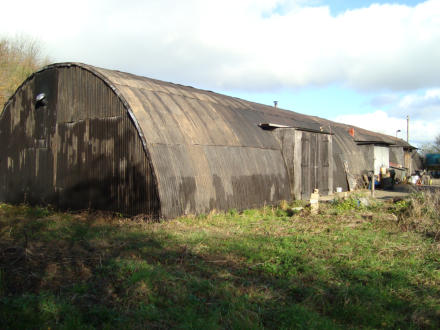


rjkdesign













